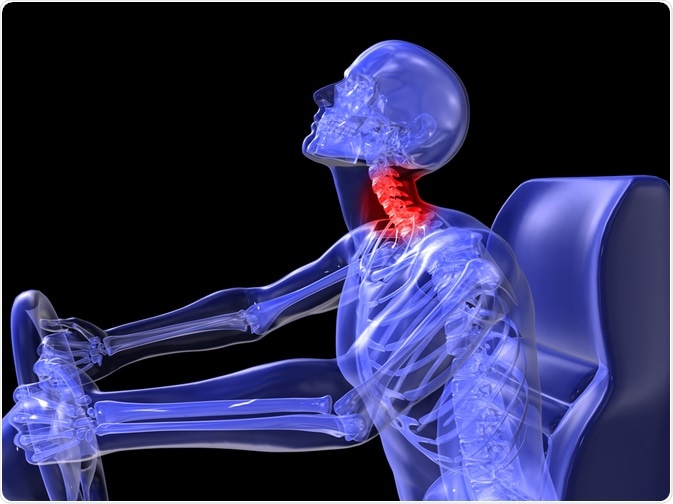Whiplash and whiplash-associated disorders (WAD) occur as a result of sudden movements of the head that cause flexion and extension of the neck, often causing damages to the tendons and ligaments in the area.
Symptoms of the condition vary in severity and duration, depending on the nature of the causative incident and the physical damage to the area.
 Image Credit: SOPRADIT / Shutterstock.com
Image Credit: SOPRADIT / Shutterstock.com
Common symptoms of whiplash
The initial symptoms of whiplash may present immediately after the incident that cause sudden movements to the head and neck or may be delayed by a few hours or days. Symptoms of whiplash commonly include:
- Pain and aching of neck and back
- Stiffness of neck
- Referred shoulder pain
- Sharp prickling sensation in arms and legs
- Headache
- Dizziness
These symptoms may initially increase in severity until they reach a peak or plateau and, in most cases, usually improve over a matter of weeks.
It is also common for people affected to feel tired, as their body adjusts to the changes and heals the damaged tendons and ligaments. This may also be linked to higher incidence of sleep disturbances, as a result of the pain and other symptoms.
Long-term symptoms of whiplash
The majority of patients that suffer from WAD make a full recovery within three months, however some people tend to experience for a longer period of time and may never be completely free from symptoms.
People who suffer from more severe and long-term WAD are more likely to notice psychological symptoms such as depression, which is commonly associated with decreased quality of life due to the condition. Some people also notice symptoms of memory loss and cognitive impairment.
 Image Credit: BioMedical / Shutterstock.com
Image Credit: BioMedical / Shutterstock.com
Quebec task force grades of disorder
In 1995 the Québec Task Force (QTF) was sponsored by the public car insurance company of Québec, Canada, to create a report summarizing WAD and make recommendations regarding prevention, diagnosis and treatment. These later evolved to become the guidelines to manage WAD claims and helped to redefine whiplash.
There are several grades of WAD in the guidelines, which are defined as:
- Grade 0 with no signs of neck pain or stiffness or other physical signs.
- Grade 1 with complaints of neck pain, stiffness or tenderness but no physicals signs present upon physician examination.
- Grade 2 with complaints of neck pain, stiffness or tenderness and evidence of decreased range of motion and point tenderness in neck upon physician examination.
- Grade 3 with complaints of neck pain, stiffness or tenderness in addition to neurological signs including weakness, sensory deficits and decreased deep tendon reflexes.
- Grade 4 with complaints of neck pain, stiffness or tenderness, with evidence of fracture or dislocations and injury to the spinal cord.
Cervical Whiplash | Trauma
Symptom management for whiplash
Most initial symptoms are usually managed with pain medications, such as paracetamol and non-steroidal anti-inflammatory drugs (NSAIDs) including ibuprofen. In some cases, particularly with long-term whiplash, antidepressants and muscle relaxants may be required.
A physiotherapist can often help affect individuals to return to normal functionality and reduce symptoms with various motion exercises and other physical therapy. Depending on the situation, a cervical collar may be recommended, although regular movement of the affected area is usually encouraged.
References
Further Reading